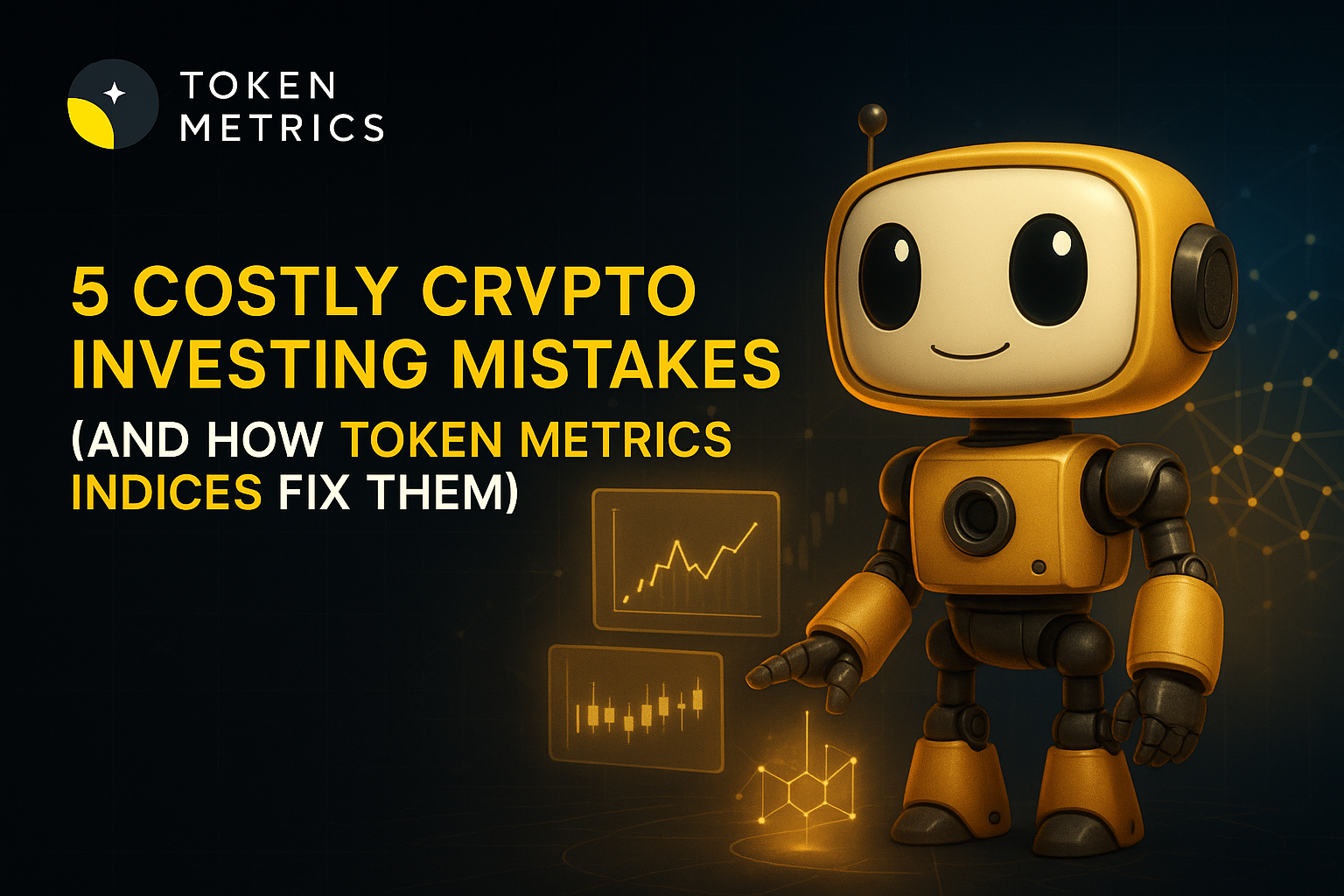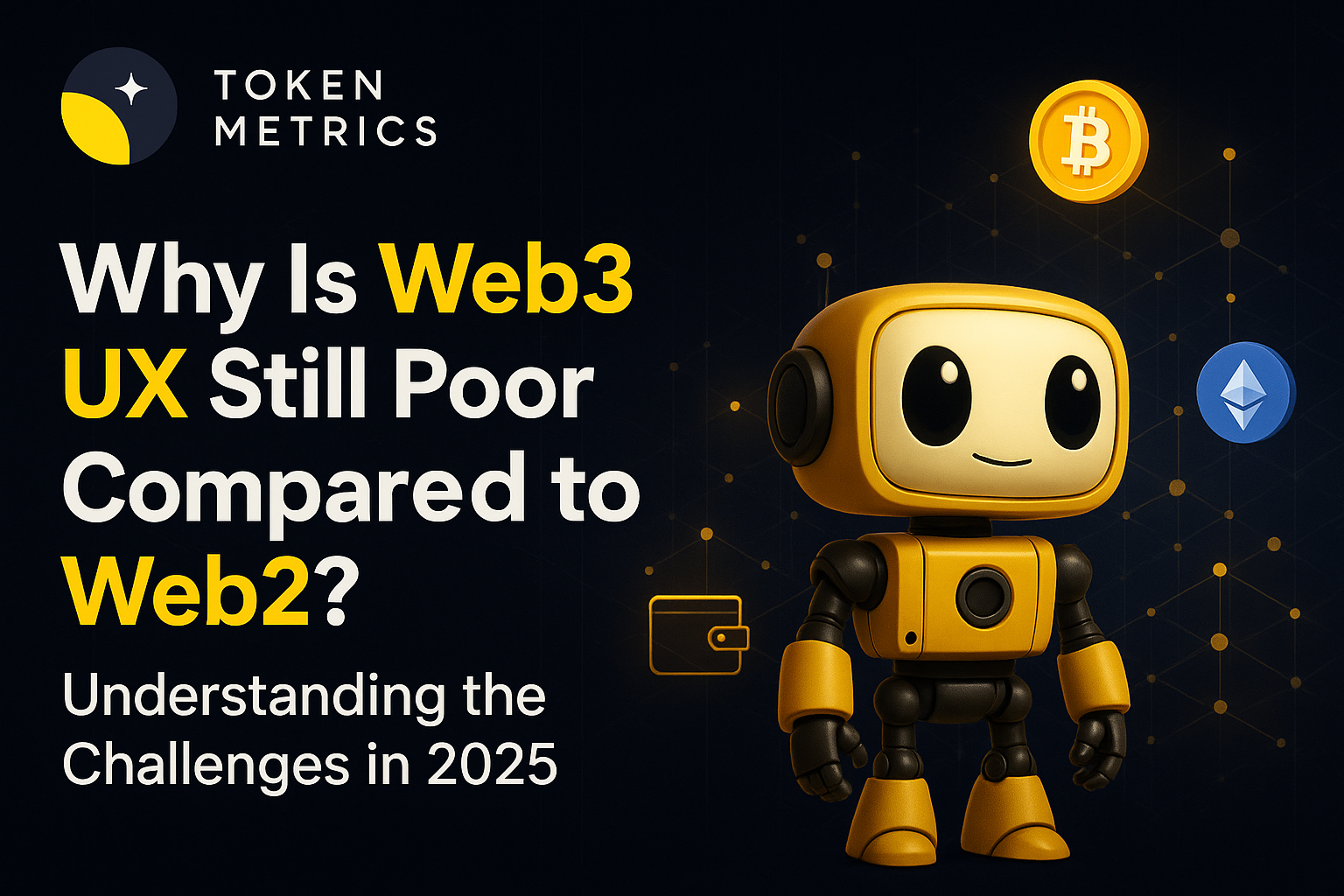
5 Costly Crypto Investing Mistakes (And How Token Metrics Indices Fix Them)

Billions of dollars vanish from the crypto markets annually, not due to scams or hacks—but simply through common, avoidable mistakes. Recent data reveals that 95% of cryptocurrency traders lose money, and the root causes are rarely market volatility or bad luck. Instead, it’s everyday errors in judgment, strategy, and execution. If you have ever bought a token near its top, held a losing position in hopes of a turnaround, or felt overwhelmed by countless investment choices, you’re far from alone. These patterns impact millions, draining away both capital and peace of mind.
The good news? Token Metrics AI indices are designed to address these exact issues. In this article, we’ll examine the five most costly crypto investing mistakes—and show how Token Metrics’ systematic approach helps mitigate them all.
Mistake #1: Buying Hype Instead of Fundamentals
The Problem
You notice a token trending on social media, backed by massive price gains and hype. FOMO prompts you to invest, even though you don’t fully understand the project. For example, in 2021, the Squid Game Token rocketed 86,000% in just a week due to hype linked to the Netflix series. Investors poured in millions—only for a "rug pull" to destroy its value, leaving those who bought at the top with 99.99% losses.
Why This Happens
How Token Metrics Solves It
Token Metrics uses AI and machine learning to analyze over 80 data points per token, including fundamentals, code quality, sentiment, and market indicators
The result? Only projects passing strict fundamental analysis are included in Token Metrics indices. Hype-driven projects are filtered out, helping protect investors from unreliable assets.
Mistake #2: Poor Timing (Buying High, Selling Low)
The Problem
Emotion-driven timing—buying during surges and selling during dips—is one of the biggest sources of loss for crypto investors. Research indicates the average investor underperforms basic buy-and-hold by 30–50% per year due to such decisions.
Why This Happens
How Token Metrics Solves It
Token Metrics indices rebalance weekly, monthly, or quarterly using algorithmic rules. The platform’s AI features:
Example: If Solana’s strength increases, Token Metrics may raise its allocation; as momentum fades, the index reduces exposure—helping avoid entire declines that manual investors often experience. This systematic, emotion-free timing can produce more consistent results than self-directed trading.
Mistake #3: Dangerous Lack of Diversification
The Problem
Concentrating heavily in a single token exposes investors to severe downside. In 2022, many held over 50% of their portfolio in Luna/UST and suffered disproportionate losses when the protocol collapsed.
Why This Happens
How Token Metrics Solves It
Token Metrics indices deliver automatic diversification:
Sample Portfolio: 30% Bitcoin, 25% Ethereum, 15% Solana, 10% Chainlink, 8% Avalanche, 7% Polygon, 5% other high-quality assets. If one token sees trouble, most of the portfolio remains protected—a proven benefit highlighted by Token Metrics’ multi-year track record of outperformance with diversified baskets.
Mistake #4: Inconsistent Portfolio Management
The Problem
Without regular review, portfolio allocation drifts: winners may become overexposed, losers get neglected, and emotional attachments override discipline. Studies show that investors who fail to rebalance underperform by 15–20% annually due to uncontrolled risk and missed opportunities.
Why This Happens
How Token Metrics Solves It
All Token Metrics indices are systematically rebalanced on a set schedule. For trading indices, rebalancing happens weekly—well-performing tokens are trimmed, underperformers removed, and new opportunities integrated. For investor indices, monthly or quarterly rebalances keep long-term allocations aligned while minimizing transaction costs.
Example: Instead of riding a token from $10 to $100 and back to $30, Token Metrics trims positions in stages, locking in gains before major declines. This systematic process produces more stable outcomes than manual, emotion-driven management.
Mistake #5: Analysis Paralysis and Information Overload
The Problem
With thousands of crypto assets, dozens of exchanges, and endless advice, many investors get stuck researching without ever taking action—or constantly shift strategies without conviction. During recent bull markets, analysis paralysis alone led to missed opportunities for significant growth.
Why This Happens
How Token Metrics Solves It
Token Metrics offers a simple, three-step process:
From there, AI research handles token analysis, portfolio selection, rebalancing, and ongoing risk management—reducing complexity and saving hours each week.
This all-in-one approach makes it possible to manage your crypto allocation in an hour per month—while leveraging systematic, AI-driven best practices.
The Token Metrics Advantage: Five Problems, One Solution
What sets Token Metrics apart for investors seeking robust, repeatable results?
Taking Action: Your Next Steps
Recognizing these mistakes is important, but building sound habits is what drives meaningful outcomes. Most investors have made at least one of these errors. The difference comes from implementing systematic solutions.
Every day of delay or indecision can contribute to preventable loss or missed growth, while proven systems work to manage changing markets with discipline.
Subscription costs, typically $50–200 monthly, are modest compared to the savings from avoiding just a single significant error. Many users note that Token Metrics’ AI prevents multiple costly mistakes each year.
Conclusion: From Mistakes to Mastery
The five mistakes covered—buying hype, poor timing, concentration, inconsistent management, and information overload—are among the most common causes of investor losses in crypto. Token Metrics’ indices offer systematic processes that remove emotion, foster diversification, drive consistent rebalancing, and simplify complex decisions. With tools built on institutional-grade AI, you can transform passive mistakes into active mastery. You don’t need to become a full-time trader or blockchain expert; you need proven systems designed to avoid the most frequent pitfalls.
Move beyond trial and error, and leverage AI-powered intelligence for smarter investing decisions with Token Metrics. Make your next move one of clarity and confidence.
Click here to signup for free trial account!
Discover Crypto Gems with Token Metrics AI
Token Metrics uses AI-powered analysis to help you uncover profitable opportunities in the crypto market. Get Started For Free
FAQs
What are Token Metrics indices, and how do they work?
Token Metrics indices are algorithmically created baskets of cryptocurrencies selected using AI-driven research. They are rebalanced systematically based on market signals, offering diversified exposure and removing emotional bias.
How does Token Metrics help avoid hype-driven mistakes?
Token Metrics rigorously evaluates project fundamentals, code quality, market viability, and liquidity, filtering out projects driven by short-term hype or weak fundamentals. Only tokens passing strict criteria are considered for inclusion in indices.
Can I customize my crypto index with Token Metrics?
Users can choose indices aligned with different investor profiles, timeframes, and styles. While each index follows an algorithmic process, you can select the one that best matches your strategy and goals.
What levels of risk management do Token Metrics indices offer?
Indices are built for risk management, including diversification limits, liquidity filters, systematic rebalancing, and AI-powered detection of changing market conditions to mitigate portfolio risk.
Is Token Metrics suitable for beginners or advanced investors?
Token Metrics is accessible for all experience levels. Beginners benefit from simplified AI-driven selection, while advanced users can access data, detailed reports, and deeper tools for more hands-on analysis.
Disclaimer
This content is for informational and educational purposes only and does not constitute investment advice or a recommendation to buy or sell any digital assets. Cryptocurrencies are volatile and carry risk; always conduct your own research and consider professional advice before making financial decisions.
Click here to signup for free trial account!

.svg)

Create Your Free Token Metrics Account

.png)




%201.svg)
%201.svg)


%201.svg)










.svg)




.png)